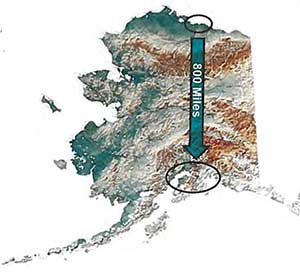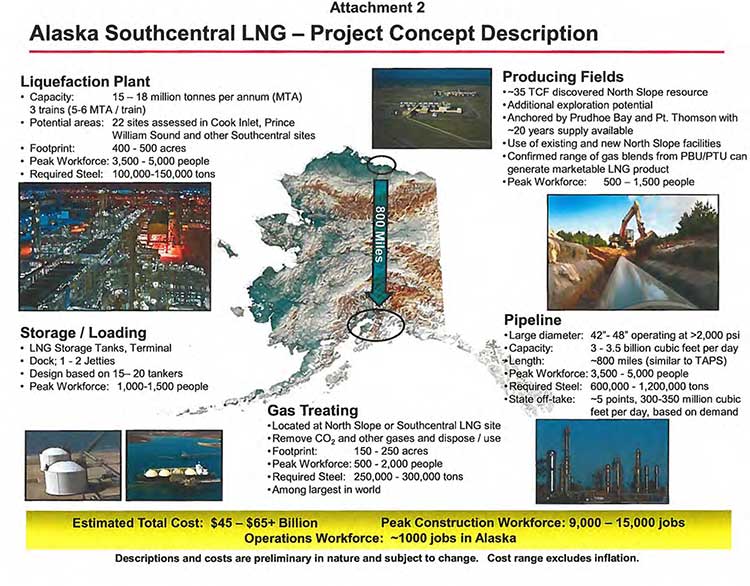An alliance of four energy companies has updated plans for a multi-billion dollar, ten-year liquefied natural gas megaproject that would take gas from Alaska’s North Slope for shipment to Asia through the oil port at Valdez.
Three of the companies, Exxon Mobile, ConocoPhillips and BP already have operations on the North Slope. TransCanada,which is already planning to build a gas pipeline for the Kitimat Shell project, would be the fourth partner and also work on the pipeline.
 The four companies filed a letter on October 1 with Alaska Governor Sean Parnell outlining the plans, The governor’s office released the letter today.
The four companies filed a letter on October 1 with Alaska Governor Sean Parnell outlining the plans, The governor’s office released the letter today.
The companies told Gov. Parnell that their efforts would result in “a megaproject of unprecedented scale and challenge; up to 1.7 million tons of steel, a peak construction workforce of up to 15,000, a permanent workforce of over 1,000 in Alaska, and an estimated total cost in today’s dollars of $45 to $65+ billion.”
Related:Alaska governor meets with three energy CEOs to push North Slope LNG exports to Asia
The letter goes on to say that TransCanada’s recently completed non-binding solicitation of
interest in the project and that company “has publicly reported interest from potential shippers and major players from a broad range of industry sectors and geographic locations.” (An expression of interest, of course, doesn’t mean that buyers will actually sign contracts, as the Kitimat LNG partners are finding out)
It appears from the letter that the North Slope producers are, in the long term, worried about diminishing oil reserves and are now, like energy companies around the world, looking at cashing in on the natural gas boom.
This opportunity is challenged by its cost, scale, long project lead times, and reliance upon interdependent oil and gas operations with declining production. The facilities currently used for producing oil need to be available over the long-term for producing the associated gas for an LNG project. For these reasons, a healthy, long-term oil business, underpinned by a competitive fiscal framework and LNG project fiscal terms that also address AGIA issues [an Alaska state agency], is required to monetize North Slope natural gas resources. The producers look forward to working with the State to secure fiscal terms necessary to support the unprecedented commitments required for a project of this scope and magnitude and bring the benefits of North Slope gas development to Alaska.
Over the past few months, the partners have, according to the letter:
•Developing a design basis for the pipeline, including areas of continuous and discontinuous permafrost
•Investigating multiple ways to remove and dispose of CO2 and other contaminants
•Assessing use of existing and addition of new Prudhoe Bay field facilities
•Mapping multiple pipeline routing variations
•Assessing multiple pipeline sizes
•Providing for at least five in-state gas off-take points
•Completing preliminary geohazard and marine analysis of 22 LNG site locations
•Developing a design basis for the required LNG tanker fleet
•Evaluating multiple LNG process design alternatives
•Confirming a range of gas blends from the Prudhoe Bay and Point Thomson fields can generate a marketable LNG product
The letter concludes:
Our next steps are to complete the concept selection phase and work with the State to make meaningful progress on the items detailed above. This work is critical as we consider decisions to progress the next phases of an LNG development project.
Alaska’s North Slope natural gas resources must compete in the global energy markets in order to deliver state revenues, in-state energy supplies, new job opportunities and other economic benefits to Alaskans. While North Slope gas commercialization is challenging, working together, we can maintain the momentum toward our shared vision for Alaska. We will continue to keep you advised of our progress and stand committed to work with the State to responsibly develop its considerable resources.


